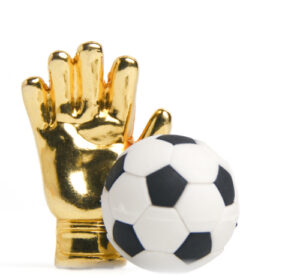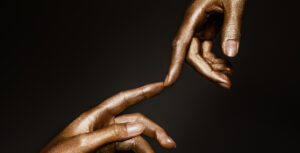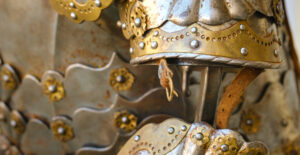
In a township field bordered by taxis and tuck shops, a boy scores a goal and runs toward his teammates with a gold chain bouncing against his chest. The crowd erupts, not just for the footwork, but for the flash. In South Africa, the relationship between soccer and gold is more than cosmetic, it’s cultural currency, tribal emblem, financial survival, and spiritual armor. The golden score is not just a tally on a board, it’s a rite of passage, a performance of identity, and sometimes, a distraction from the deficit.
Walk through any informal settlement or inner-city pitch and you’ll see it, boys with second-hand boots, borrowed jerseys, and a glint of metal that outshines the setting sun. The gold chain, whether real, plated, or wishfully bought, is more than a fashion statement. It’s an anchor. It says, “I’m here. I’m someone. I shine, even if the world won’t let me.”
Soccer and gold have always had a complicated love affair. Across the globe, the World Cup trophy itself is a golden grail. But here in South Africa, that connection digs deeper. Gold isn’t just what you win, it’s what you wear to prove you’ve made it, even if just for 90 minutes. For players in local leagues, many of them unpaid, some barely fed, the gold chain is often the most valuable thing they own. It’s their statement piece, their performance bonus, their personal sponsorship deal when none exist. Coaches may bark at them to take it off before kickoff, citing safety. But many don’t. Because removing the chain isn’t just about rules, it’s about stripping dignity.
There’s a story in every chain, a grandmother’s wedding ring melted down and remade, a pawn shop deal that got reversed just in time, a friend’s gift after a big win in a dusty tournament with no media coverage but plenty of heart. These aren’t trophies handed out in velvet boxes. They’re lived-in, sweat-stained symbols of hustle and hope.
But what happens when the golden score turns into a golden curse?
Pawn shops across Gauteng are lined with the aftermath. Chains traded in for taxi fare, medical bills, or rent money. Sometimes the players come back for them. Sometimes they don’t. And sometimes, what they thought was gold turns out to be brass, and the money they thought they’d bank on vanishes like a missed penalty in the wind.
It’s a system that preys on image and desperation. A player scores the winning goal in a regional cup. He’s photographed with a massive Cuban link chain he borrowed for the day. The picture gets likes, retweets, and eventually lands him a small-time sponsor. But the pressure mounts, he has to maintain the look. He buys the chain. Then the contract falls through. The rent’s overdue. And suddenly the gold that crowned him now drags him down.
There’s a term that’s been floating through locker rooms and WhatsApp groups, “Loan Shine.” It’s the act of borrowing gold to create a moment, to stage a photo, to tell the world you’ve arrived. But just like loan sharks, Loan Shine comes with invisible interest. The cost? Credibility. Stress. The fear of being exposed.
Still, there’s magic in the metal. For many South African players, gold is more than bling, it’s ritual. It’s the chain you kiss before taking a penalty, the bracelet you tap twice before the whistle blows. It’s part of the mental armor, the spiritual handshake between faith and ambition. And whether it came from a dealer in downtown Jozi or your uncle’s bottom drawer, it carries weight.
 In elite leagues, the glint has gone official. Sponsorships, bonuses, and player profiles now include luxury watches and chains as part of their brand package. You’ll see Bafana Bafana stars on magazine covers draped in gold, the same way European stars flash Rolexes and designer studs. But unlike in Europe, where wealth is expected and often inherited, South Africa’s gold always whispers of the hustle behind it.
In elite leagues, the glint has gone official. Sponsorships, bonuses, and player profiles now include luxury watches and chains as part of their brand package. You’ll see Bafana Bafana stars on magazine covers draped in gold, the same way European stars flash Rolexes and designer studs. But unlike in Europe, where wealth is expected and often inherited, South Africa’s gold always whispers of the hustle behind it.
And the hustle is real. Ask any rising star from Soweto, Mitchells Plain, or Umlazi how they got their first chain, and the story won’t involve a boutique, it’ll involve a cousin’s plug, a lucky tournament, or a side hustle in barbershops or betting kiosks. The gold is never just a purchase, it’s a payment in faith, a bet on self, a shine earned the hard way.
There’s also a growing movement among younger players to redefine the bling. They’re wearing gold that tells stories, names of lost friends engraved in pendants, chains with cultural symbols, bracelets passed down from mothers who believed in them before scouts did. In these small rebellions of style, gold becomes not a symbol of ego, but of memory.
Still, the tension lingers. For every boy who scores in gold, there’s another who’s sold his chain to stay afloat. The game may reward talent, but image still dictates opportunity. And in a country where inequality shows in everything from education to access to training facilities, gold often becomes the great equalizer, or the great illusion.
The pitch remains sacred ground. It’s where futures are forged and reputations built. And on these fields, gold remains part of the uniform, unofficial, yet essential. It’s worn with pride, kissed with gratitude, and sometimes pawned with shame. But always, it returns.
Because in South Africa, scoring a goal isn’t just about beating the keeper. It’s about reclaiming dignity. About shining, however briefly, in a world that often dims black joy, black beauty, and black brilliance. And sometimes, that glow comes on a chain around your neck.
The golden score is a heartbeat. A pulse of pride, poverty, perseverance. And whether it’s plated or pure, the gold still matters, because to the ones who wear it, it means they’re still in the game.



